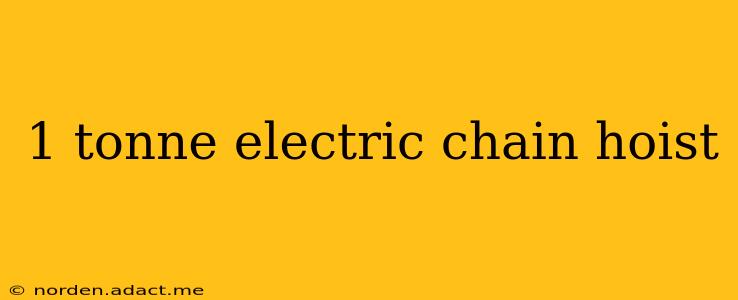Choosing the right electric chain hoist is crucial for any lifting application, ensuring both efficiency and safety. A 1-tonne electric chain hoist is a popular choice for a wide range of industries and tasks, offering a balance of lifting capacity and maneuverability. This comprehensive guide will explore everything you need to know about selecting and using a 1-tonne electric chain hoist.
What is a 1 Tonne Electric Chain Hoist?
A 1-tonne electric chain hoist, also known as a 1000kg electric chain hoist, is a lifting device capable of lifting loads up to 1000 kilograms (approximately 1 metric ton). It uses an electric motor to power a chain mechanism, allowing for the controlled raising and lowering of heavy objects. These hoists are highly versatile, finding applications in factories, warehouses, construction sites, and workshops.
What are the Different Types of 1 Tonne Electric Chain Hoists?
Several factors differentiate 1-tonne electric chain hoists, impacting their suitability for specific tasks:
Suspension vs. Trolley Mounted:
- Suspension: These hoists are directly suspended from an overhead beam or support structure. They are ideal for lifting loads in a fixed location.
- Trolley Mounted: These hoists are mounted on a trolley that allows them to move horizontally along an I-beam, providing greater reach and flexibility.
Single-Phase vs. Three-Phase Power:
- Single-Phase: Suitable for lighter-duty applications and locations with single-phase power supplies.
- Three-Phase: Designed for heavier loads and applications requiring higher power, commonly found in industrial settings.
Wired vs. Wireless Control:
- Wired Control: Offers greater reliability and is commonly used in industrial environments.
- Wireless Control: Provides increased flexibility and convenience, but may require more careful consideration of signal strength and interference.
What are the Key Features to Consider When Choosing a 1 Tonne Electric Chain Hoist?
Selecting the right 1-tonne electric chain hoist involves considering several key features:
- Lifting Height: Determine the required lifting height for your specific application. Different hoists offer varying lifting capacities.
- Lifting Speed: Choose a lifting speed that balances efficiency and safety for your specific workload.
- Duty Cycle: The duty cycle specifies the hoist's capacity for continuous operation. Heavy-duty hoists are designed for extended use.
- Safety Features: Look for features such as overload protection, emergency stops, and limit switches to ensure safe operation.
- Chain Type and Grade: The chain type and grade directly influence the hoist's durability and load capacity. Ensure the chain meets the requirements of your application.
- Motor Type: The motor's power and efficiency should align with your anticipated workload.
- Maintenance Requirements: Consider the ease of maintenance and the availability of spare parts.
How Much Does a 1 Tonne Electric Chain Hoist Cost?
The cost of a 1-tonne electric chain hoist varies significantly based on features, brand, and supplier. Prices can range from a few hundred dollars for basic models to several thousand dollars for high-capacity, heavy-duty hoists with advanced features.
Where Can I Buy a 1 Tonne Electric Chain Hoist?
1-tonne electric chain hoists are widely available from various suppliers, including online retailers, industrial equipment distributors, and specialized lifting equipment companies.
What is the Maintenance Required for a 1 Tonne Electric Chain Hoist?
Regular maintenance is crucial for ensuring the longevity and safe operation of your 1-tonne electric chain hoist. This includes regular inspections, lubrication, and any necessary repairs by qualified technicians. Consult your hoist's manual for specific maintenance schedules and procedures.
What Safety Precautions Should I Take When Using a 1 Tonne Electric Chain Hoist?
Safety is paramount when operating any lifting equipment. Always follow these precautions:
- Proper Training: Ensure all operators receive adequate training before using the hoist.
- Regular Inspections: Inspect the hoist before each use for any damage or wear.
- Load Capacity: Never exceed the hoist's rated load capacity.
- Proper Rigging: Use appropriate lifting slings and shackles to secure the load.
- Clear Area: Maintain a clear area around the hoist to prevent accidents.
- Emergency Stops: Familiarize yourself with the location and operation of emergency stops.
This comprehensive guide provides a solid foundation for understanding 1-tonne electric chain hoists. Remember that selecting the right hoist and prioritizing safety are critical factors in ensuring efficient and risk-free operation. Always consult with a qualified professional for assistance with complex lifting applications or if you have any questions or concerns.
